Brandon Gibson says the first time he studied film on Daniel Cormier, he was in a truck stop outside Amarillo, Texas.
It was mid-summer, and Gibson was on his way home from visiting family in Ohio. He was nearing the end of the marathon drive back to Albuquerque when UFC light heavyweight champion Jon Jones called with breaking news. Top contender Alexander Gustafsson was out of their UFC 178 bout with a knee injury. Now, Jones would fight Cormier instead.
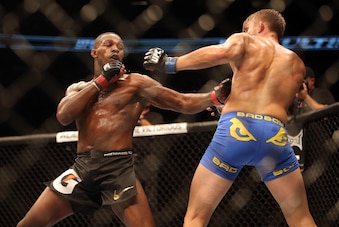
Gibson was somewhere out on I-40 when he found out all the work they’d put in preparing to rematch the lanky, 6-foot-5 kickboxer would go to waste. The way he tells the story—and certainly he’s paraphrasing—his response to learning Gustafsson would be replaced by the stocky, undefeated former Olympic wrestler was two words.
“All right.”
If anything, maybe that’s Gibson in a nutshell—serene exterior, calculated, a little bit zen—but inside, his trainer’s brain was already spinning. The next time he pulled over for gas and discovered the roadside truck stop had Wi-Fi, he slipped out his phone to see what he could see on the new opponent.
“I started jotting down notes,” Gibson tells Bleacher Report. “I wanted at least to start rehearsing things in my mind. Then, that night when I got back to Albuquerque, we got together and started hitting mitts.”
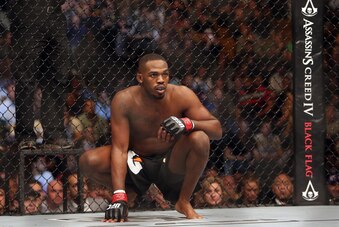
That was five months ago. After another injury delay—this time owing to Jones’ own knee surgery—the champ will finally meet Cormier on Saturday at UFC 182. It will be the culmination of the eighth fight camp Gibson has worked as Jones’ striking coach at the famed New Mexico gym owned by Greg Jackson and Mike Winkeljohn.
So far, all of them have ended with victories.
The 32-year-old Gibson trains nearly all of the fighters at Jackson-Winkeljohn, but his relationship with Jones is a special one. During the last three-plus years, they’ve grown close enough for Jones to casually call him a brother, even though the fighter has two real biological brothers who both play in the NFL. Earlier in 2014, Jones also playfully referred to Gibson as his “secret weapon” on social media.
It seems as though they are always together—working out, traveling, meeting for private sparring sessions in the evenings. If anyone in MMA truly knows the sport’s most unbeatable, most unknowable champion, it may well be Gibson.
“He makes you feel as if it’s not just about money or fame or accolades with him,” Jones says. “It’s really about him genuinely wanting to see you do better in life. He cares about our families. It’s more than just a coach and his athletes. He really has created a brotherhood, at least for me.”
Appearance-wise, the two have a bit of an Odd Couple vibe going on. In pictures of them together—and there are a lot of them—the top of Gibson’s head comes just to Jones’ chin. Gibson runs about 160 pounds, while Jones walks around at a lithe 220. Spend even a few minutes talking to either one of them, though, and it’s instantly clear why they’ve become such a formidable team.
Here are two thoughtful, unorthodox dudes, both gym rats, who both share a deep love for strategy and the psychological side of the fight game.
Jones is notoriously obsessive. The stories of him learning to fight by watching YouTube videos and taping off the physical dimensions of his opponents on a wall in his apartment are legendary. While Gibson is way too chilled-out to fit that same adjective, single-minded feels like an accurate descriptor for him. People who know him best will tell you this thing about pulling over at a truck stop to start game-planning for an upcoming fight? That’s not an isolated incident. That’s not even unusual.
“Half the times I call him, he’s always studying,” Jones says. “He’s always studying my opponent for me. I study myself, but he’s always studying. (He’ll say) ‘What do you think about trying this?’ or ‘Did you notice that he does this?’ Each opponent is very personal for him. I love that passion that he brings into the fight.”
Perhaps Gibson’s biggest strength is his ability to build relationships with the athletes he trains. That’s what Jones says, anyway, that Gibson just understands fighters. He knows how to motivate from minute to minute, which is a plus when you’re grinding through the drudgery of one long, difficult fight camp after another.
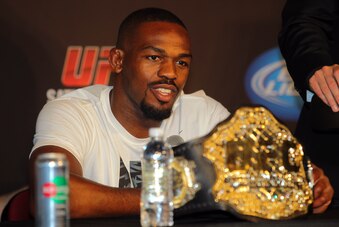
Gibson likes to send around inspirational quotes. He uses music and video clips, is constantly on the lookout for the thing he thinks might help the men and women he trains be at their very best for the next film study session, the next round of sparring, the next morning conditioning drills.
And, sure, the intellectual, quasi-spiritual guy with a penchant for motivational quotes isn’t exactly a new thing. It’s fairly well-worn territory in fight gyms, but Gibson is so open-hearted and impassioned that it’s impossible not to like him for it. When he talks about other fight gyms, he sometimes calls them “schools”—maybe a chip off the block of Greg Jackson, who occasionally refers to his own fighting system as a “curriculum”—and when he discusses drills and sparring, he often uses the word “rehearsal.”
It’s a small thing, this quirky use of language, perhaps insignificant. But are Cormier and the rest of his team at San Jose’s American Kickboxing Academy calling what they do every day “rehearsal”? Probably not. Maybe that hints at the mindset that makes Gibson and the rest of the Jackson-Winkeljohn team so unique and, they would probably argue, uniquely successful.
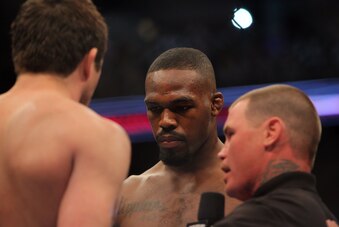
A conversation might start with Gibson talking about Jones, their relationship and what they’re doing to beat Cormier this weekend, but soon it drifts. He brings up Chuck Close, the contemporary American painter and photographer who is now a quadriplegic and in 2014 got a bunch of top Hollywood celebrities to pose with no makeup for Vanity Fair.
He mentions his admiration for Winkeljohn’s mastery on the mitts and Jackson’s way of using bits of history or the works of great artists to motivate his fighters.
In the end, he digs out this St. Francis of Assisi quote he likes, saying, “I’m more of a Buddhist than anything,” as a sort of half-apology for the religious undertones.
“'He who works with his hands is a laborer,'” Gibson quotes, reading it off his phone to make sure he gets it right. “'He who works with his hands and his head is a craftsman. He who works with his hands and his head and his heart is an artist.' That’s what I try to instill in my fighters. Let’s go out there and make some art, you know? Let’s put everything into this.”
*****
Gibson grew up in southeast Albuquerque, in the same neighborhood where the Jackson-Winkeljohn gym is today. He went to neighboring high schools with future Jackson fighters Diego Sanchez and Holly Holm. Like Sanchez, he remembers it as a rough place during the mid-to-late 1990s, where gangs and crime were plentiful.
Perhaps as a way to keep his kid out of trouble, Gibson’s dad signed him up at a local karate gym. Every day, he hauled his gi to school with him in his backpack. As soon as class let out for the day, he walked straight to the dojo where, as Gibson puts it, he’d “hit the makiwara boards and practice my kicks" until his dad came to pick him up after work.
“Martial arts was a survival tool,” he says. “It was something that allowed me to keep my self-respect, just because of the environment of that neighborhood.”
12,000 ft. 25 degrees. Focused. We love what we do. #AndStill @JonnyBones pic.twitter.com/cUkQYueK1W
— Brandon Gibson (@SixGunGibson) December 20, 2014
As a teenager, he got into boxing, enamored with the history and rhythms of Albuquerque’s thriving fight scene. He found his way to Winkeljohn’s kickboxing gym just as the coach’s partnership with Jackson took hold. Sanchez was there, and other fighters like Keith Jardine and Joey Villasenor were starting to make names for themselves at MMA’s highest levels.
Gibson fancied himself an amateur fighter for a while, taking boxing and kickboxing bouts at anywhere from 145 to 170 pounds, depending on which of his opponents showed up. Before he could really establish any momentum, though, he suffered a double tibia-fibula fracture he compares to the one that felled former UFC middleweight champion Anderson Silva at the end of 2013.
“That required a few operations,” Gibson deadpans. It also necessitated some tough choices.
“I never had that super competitive hunger as a fighter,” he says, “but I definitely loved the strategy. I loved the intellectual side of it, the technical side of it. I always had good leadership qualities, and I think that just transitioned more into coaching than fighting on my own. I think that was always the more natural path for me.”

He started at the bottom of the Jackson-Winkeljohn coaching tree, working with amateur fighters and even teaching a few of the youth classes the gym offered for a time. He began studying under what he calls the “very yin-yang coaching dynamic” of the two men whose names are still on the sign out front. Today, Gibson says he’d like to think his own style splits the difference between the high-minded strategy of Jackson and Winkeljohn’s more hard-nosed, technical wizardry.
His mentors seem to concur.
“Brandon is an amazing coach,” says Jackson. “He’s very creative. He’s everything we like about good coaching. He keeps his head level in stressful situations, he’s consistent, and he has a great relationship with all of his fighters. We're lucky to have him. Really lucky.”
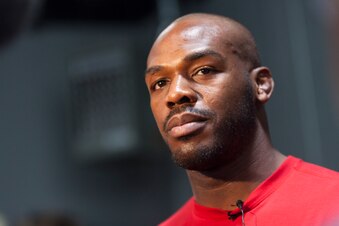
Gibson was still just a fledgling trainer when Jones started showing up in New Mexico to train for his early fights. At the time, Jones was also an up-and-comer, splitting his camps between Albuquerque and his home state of New York. Gibson says one of the first things he remembers about Jones is how young he was, not even old enough to drink. On nights when the rest of the team would head out to blow off steam, Jones would go to the movies.
They became friends before they ever formalized a working relationship. Gibson says he was still working mostly with amateurs, but he and Jones always seemed to wind up at the gym at the same time—maybe because they were both always at the gym. They used to try to out do each other in shadow-boxing competitions, each guy mixing funky, unconventional moves into his punching and kicking combinations, and the other trying to keep up.
It wasn’t until the summer of 2011 that Jones asked Gibson to begin training him. He’d just won the UFC 205-pound title in a blowout over Mauricio “Shogun” Rua and was working his way back from a lingering injury in order to make his first defense against Quinton “Rampage” Jackson in the fall. Jackson was renowned primarily for his boxing, and Jones wanted a little extra help with his own stand-up game.
“My specialty is probably a little bit more boxing,” Gibson says. “I really like to focus on boxing for MMA. So Jon said, ‘Hey man, I see you have great hands, and all your fighters have great defense. I think this is an important fight for me to work that stuff on.’ So we sat down with Greg and Winkeljohn, and I started becoming part of the team.”
The result was another wipeout win. Jones submitted Jackson with a rear-naked choke in the early stages of the fourth round after flummoxing him with his reach on the feet for most of the first 15 minutes. After the fight was over, Jones admitted he’d wanted to prove he could strike with Jackson and beat the veteran fighter at his own game.
Three months later, he fought and defeated another feared striker in Lyoto Machida, and the Jones-Gibson partnership was off and running.
*****
They are making a list.
Jones, Gibson and the other coaches at Jackson-Winkeljohn keep a bunch of lists, actually, dating back to the time they first started working together. They are master charts detailing every technique Jones prepped during his previous fight camps. Now, they’re compiling one for Cormier, too, plotting out strategies they’ve identified from copious film study on the 35-year-old No. 1 contender.
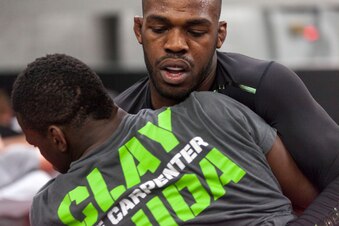
Gibson says he and Jones will often dig out the old lists and go over them, looking for similarities and differences, brainstorming what might or might not work for an upcoming fight. Some days, they might rehearse moves from the Machida fight or Jones' previous fights against Chael Sonnen or Vitor Belfort. Even if those opponents appear to have little in common with, say, Cormier, they’re constantly looking for threads from past game plans that they can weave into the new one.
Once they identify something, they drill it and drill it, conditioning Jones’ mind and body through sheer repetition so that he’ll react automatically if an opening presents itself during the actual fight.
“That’s beautiful,” says Winkeljohn, “because that’s how Jon thinks. If he’s willing to get the repetition in, then it becomes second nature to him. Jon comes with so much unpredictable stuff in the cage, but behind the scenes—people don’t understand—there’s a lot of reps of that unpredictable stuff. We know it’s not unpredictable, it just looks unpredictable to everybody else. A lot of that has to do with Brandon working reps with Jon.”
When great minds come together.. Another great workout tonight pic.twitter.com/eS6rXEflqh
— Jon Bones Jones (@JonnyBones) December 18, 2014
After the first real close call of Jones’ career at UFC 165, there were whispers that the champion had taken Gustafsson lightly, that he didn’t prepare as thoroughly as he should have. Seven months later, he was back to his old, dominating self against Glover Teixeira at UFC 175, and his coaches say Jones will never make the same mistake again. Especially not against a fighter the caliber of Cormier.
Gibson compares the intensity of this camp to the one Jones had before he defeated Rashad Evans in a contentious grudge match at UFC 145. Still, there have been plenty of distractions.

Jones had knee surgery in August and will have been out of the cage a bit more than eight months by Saturday night. In the interim, he and Cormier were both fined by the Nevada State Athletic Commission after they brawled on stage during a media event at the MGM Grand Hotel in Las Vegas. The pair were also caught in a profanity-laced spat (NSFW language in link) when they thought ESPN cameras weren’t filming. In November, Jones committed another in a long line of media gaffes, with his tone-deaf comments to TMZ.com about rape allegations against Bill Cosby.
None of it has helped endear him to that segment of MMA fans who have always viewed him as arrogant and unlikable. To that end, Gibson seems to acknowledge that part of his job is to pull Jones back from these digressions, to refocus him away from the things that cause fighters to “lose sight of the bigger picture of them being martial artists and living this warrior lifestyle.”
“Sometimes for Jon it’s not about, you know, there’s this big looming fight with Daniel Cormier,” Gibson says. “Sometimes it’s just about, let’s conquer this round on the mitts. Let’s conquer this workout. It doesn’t always have to have this looming picture of ‘here comes the fight.’ Sometimes it’s about being the best we can be in this moment.”
Concerning what will actually happen when Jones and Cormier meet in the cage, predictions are all over the map. As of this writing, Jones is going off as a slight favorite, according to Odds Shark. While some analysts think his size and mobility will easily win the day, the coaches at Jackson-Winkeljohn say Cormier stacks up as the most difficult test of Jones’ career.
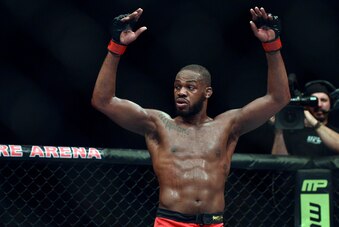
“We have to dictate the pace,” Gibson says. “I think that’ll be the biggest thing. DC loves controlling the pace and pressure of the fight. The more we can disrupt that, the more we can impose our own. I think Jon is the king of that in his own right. It’s very hard to impose your will on Jon Jones.”
While nobody is quite sure what will happen during, there is already plenty of talk about after. If Jones gets past Cormier, he’ll likely meet up with the winner of Gustafsson’s January bout against Anthony Johnson. If he gets through that, the champion says he might finally give heavyweight a spin.
There are also reports that Jackson and Winkeljohn will open a sprawling new facility in Albuquerque in 2015, and that Jackson might soon look to spread his MMA curriculum through gyms nationwide. Exactly what that would mean for a homegrown coaching star like Gibson is anybody’s best guess, though he says he’ll be content so long as he can keep working with his fighters.
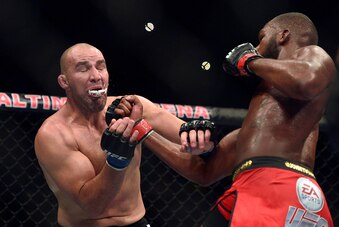
At this point, the only thing he’s willing to concede is that, with a couple of days remaining before the next big fight of all their lives, the game-planning never stops.
“We’re going to bring this team together like we always do,” Gibson says. “Now we’re at an even higher level than ever before. Our eyes are clear, our voices are loud. Jon’s going to get in there very well rehearsed. I’m not picking a round or a technique or anything like that, but it’s my job to make sure that he has all of these tools that when we create an opportunity or an opening, we will attack and do what we do best.”
Chad Dundas is a Lead Writer for Bleacher Report. All quotes were obtained firsthand unless otherwise noted. B/R MMA Editor Brian Oswald also contributed reporting to this story.






























